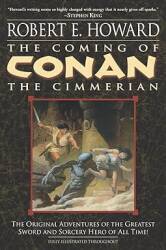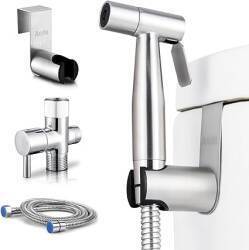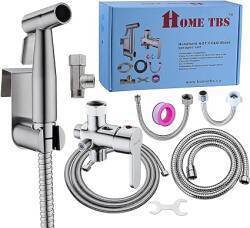
Fez
Fez — Toilets of Morocco
VisitingFez
Fez
was the second of three imperial cities
I visited in Morocco,
places where the Sultan lived.
Meknès and Marrakech were the other two.
I traveled by train from Meknès to Fez.
Then a petit taxi took me from the train station
in the ville nouvelle to the edge of
Fez el Bali,
the medina,
the walled ancient city of Fez.
Cars can't enter the medina because it has no streets
suitable for motor vehicles larger than
mid-sized motorcycles and small delivery carts.
All the passages are narrow with
small intersections, tight turns, and staircases in places.
Fez el Bali is described as the world's largest
car-free pedestrian-only urban zone,
covering about 300 hectares.
Fez el Bali is usually described as
home to 350,000 people with
9,875 named streets or lanes or passages,
350 mosques,
and zero cars.
The last number has to be true because of physical limitations.
The others are numbers heard in the medina,
and thus should be taken as approximations.
The medina's immense sand-colored walls with elaborate gateways
seemed to me to be out of Central Asia,
or maybe Robert E. Howard's tales of the
Hyborian Age.
However, Fez is 5 degrees west of London!
Tala'a Sghira to Dar Chourouk
Findingmy lodging
In most medieval cities, the main street runs from the main gate through the market area to the main mosque. In Fez el Bali the main street is Tala'a Kebira. Parallel to it is Tala'a Sghira, the street where my guesthouse was located.
A large old city such as the Fez medina contains a large number of neighborhoods which are largely independent. Each neighborhood is based around its mosque. There will be a fountain near the mosque, providing the water needed for ablutions before prayer. The fountain also serves as a general supply of water for the neighborhood. The fountain's source will also supply a nearby public toilet.
The water is also used for the neighborhood's hamman or public bath. The bath water needs to be heated. The water's source of heat will probably be used to operate the neighborhood's bakery. Individuals and restaurants make their own bread loaves, puncture them with their own distinctive pattern of small holes, and take them to the bakery to be baked.
Yes, this is Fez el Bali, a UNESCO World Heritage Site. Of course any foreign visitor will want to walk through this area. However, many of the businesses are strictly of local interest. Very few tourists commission a custom gravestone.
The gravestone workshop made for a distinctive landmark as I made my way back to my guesthouse during my stay in Fez. Also notice the "WC" sign just beyond the workshop.
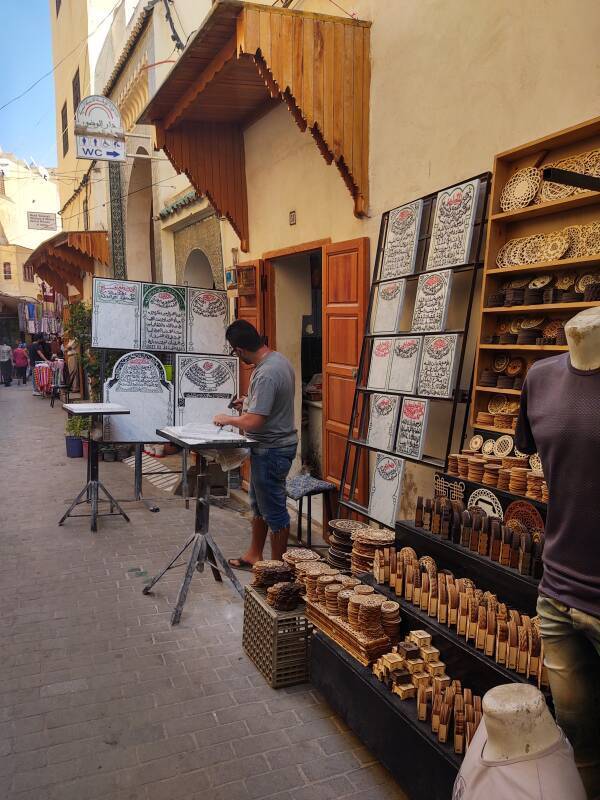
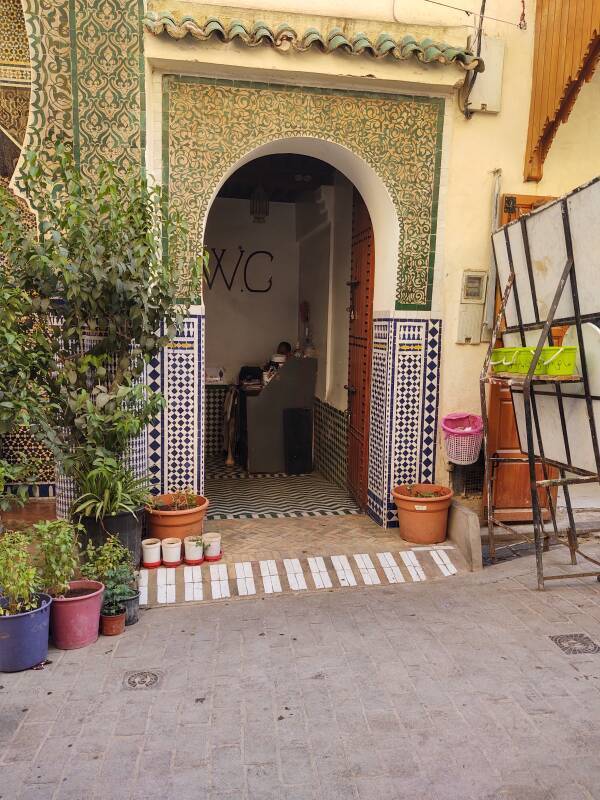
Just past the gravestone workshop was the neighborhood's prominent public restroom and fountain.
Almost all of the fountains in the medina were operating, providing many opportunities to top off my water bottle. Vegetal or vine-like patterns surround the fountain. Within its recess, elaborate zellij geometric patterns dominate.
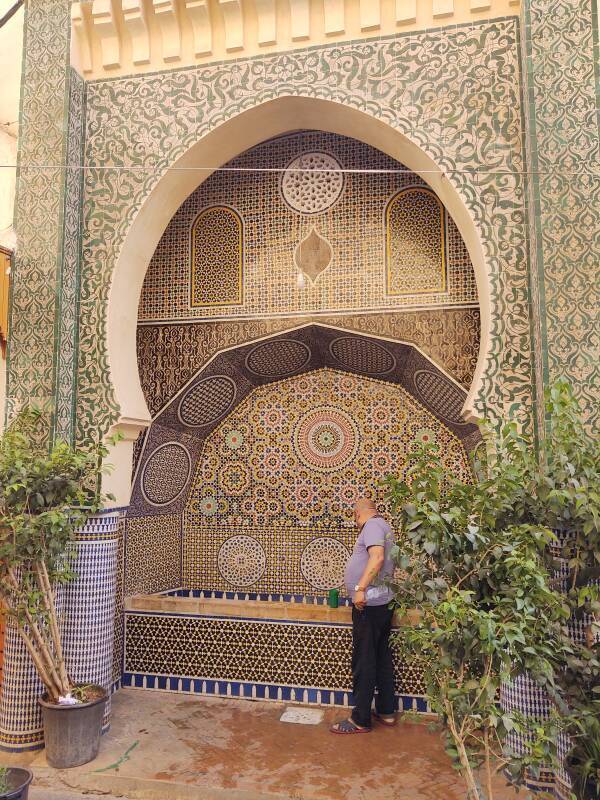
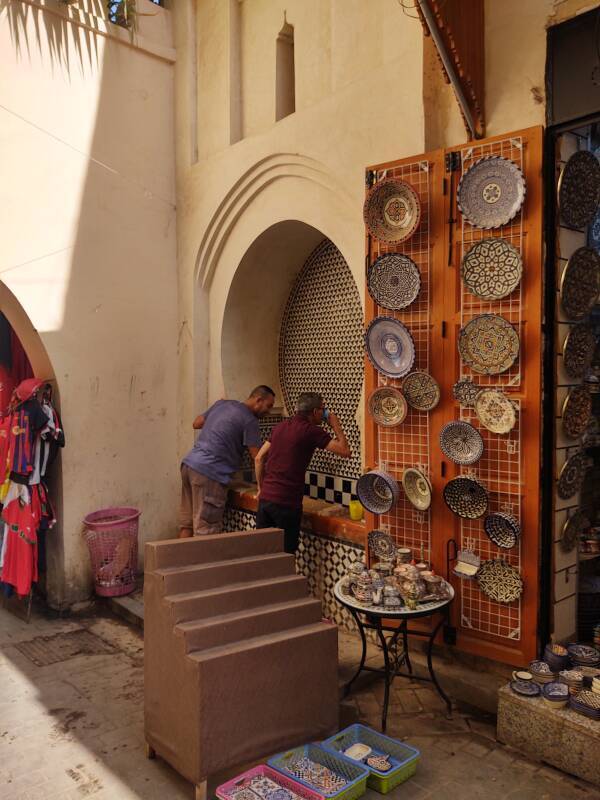
Not far beyond that first fountain, I had crossed into another neighborhood, territory of another mosque, and home to another fountain (and toilets, and hammam, and bakery).
Guesthouses at Booking.comI stayed at the Dar Chourouk guesthouse. It's on a derb or dead-end passageway. As in many derbs, buildings on opposite sides bridged over the passageway and made it effectively a darkened hallway.
Like many of the places where I stayed in Morocco, it was built like a small fortress. There are very few exterior windows as the buildings are constructed right against each other.
The room was very nice, and with VAT and a city tax surcharge included it cost just 120 Dirham a night, or about US$ 11.
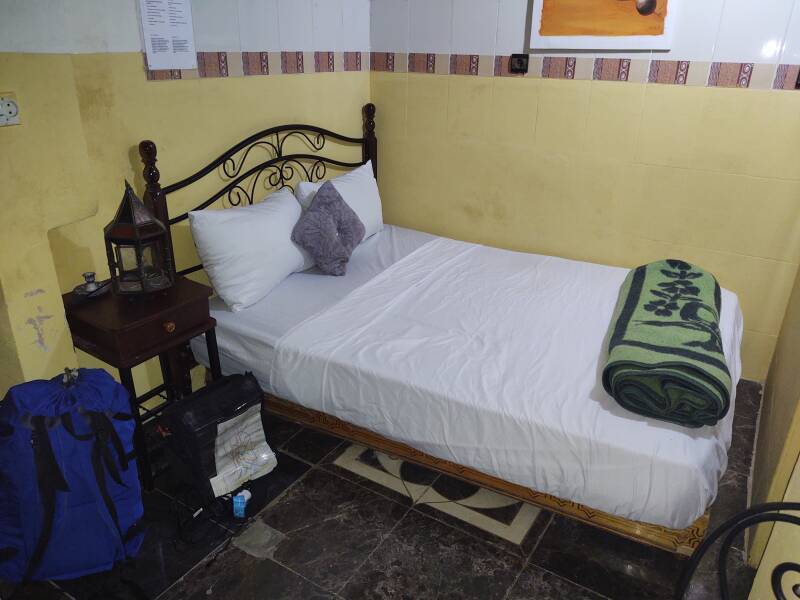
It included a private bathroom, right through that door.
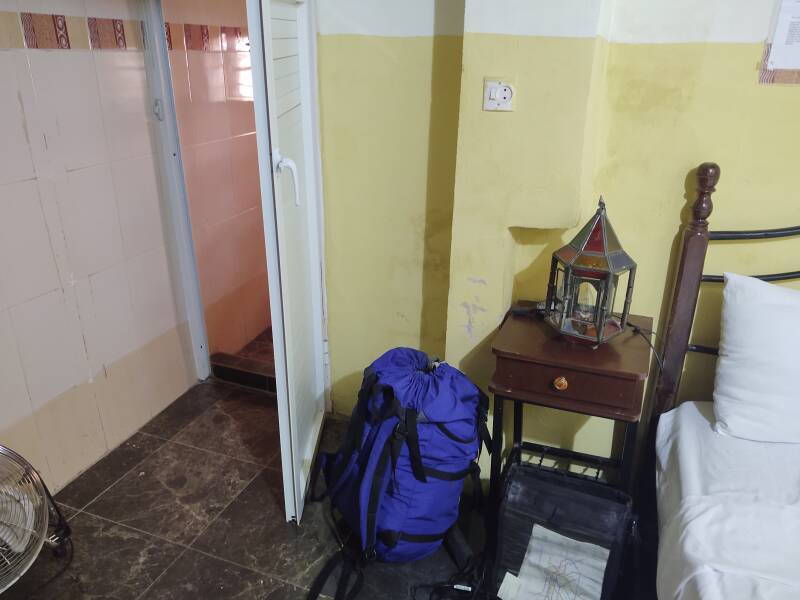
The bathroom had my only window. It looked out across Tala'a Sghira, two floors above street level to the building just a short distance across the street. The shower was the far end of the room. The valves are just beyond the sink, and the shower head fit into the fixture on the wall beyond the mirror.
The hot water line came down from the far left ceiling corner, ran along the top of the street-side wall, then came down to the shower valves. The cold water line came down from the diagonally opposite ceiling corner, supplying the toilet, sink, and shower valves in that order.
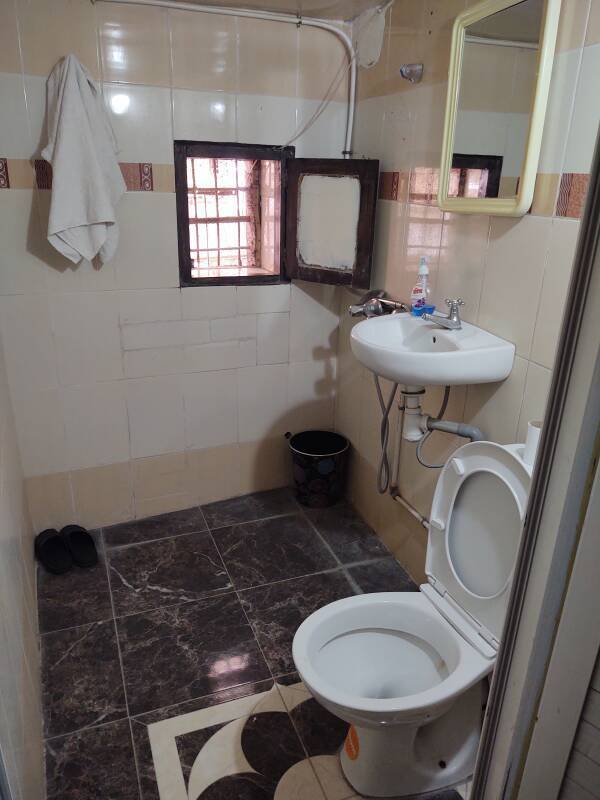
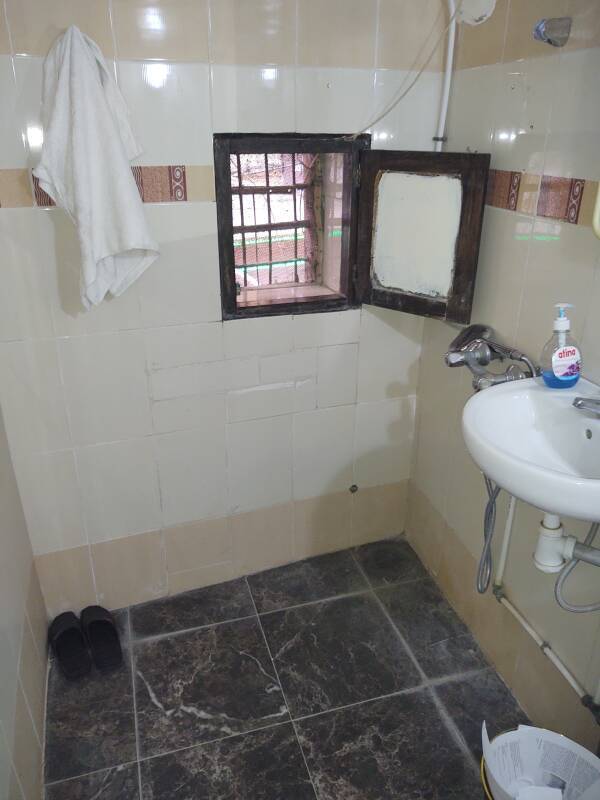
Leaving the window and bathroom door open overnight, I would hear things happening out on the street. I noticed that the medina is busy well up into the evening. But things really shut down overnight and it's silent. Once in a while a motor scooter or a small motorcycle might come through, but those are the only motor vehicles that can move through the medina.
Wipe or Wash?Paper or Water? Bowl or Bin?
Where do I put used TP?
So how do you clean yourself here? With paper or with water?
Notice the roll of toilet paper sitting on the toilet tank next to the large-or-small dual flush buttons. Also notice the trash bin beside the toilet. And also notice the hose hanging from a nail on the wall beyond the toilet.
There's toilet paper, and I always put my used paper in the trash bin and not down the toilet. I asked the "Bowl or bin?" question at some of the places where I stayed. They were almost always vague.
I speculated that maybe Moroccan plumbing is almost universally large and clear enough to handle toilet paper, at least in reasonable amounts. Toilets where I stayed usually had roughly 15cm / 6" drain lines, like this one.
One of my innkeepers explained that there would be no problem with putting the toilet paper into the bowl because they were careful to always purchase proper toilet paper that quickly breaks down in water. Use toilet paper, don't put sturdier facial tissues into the toilet.
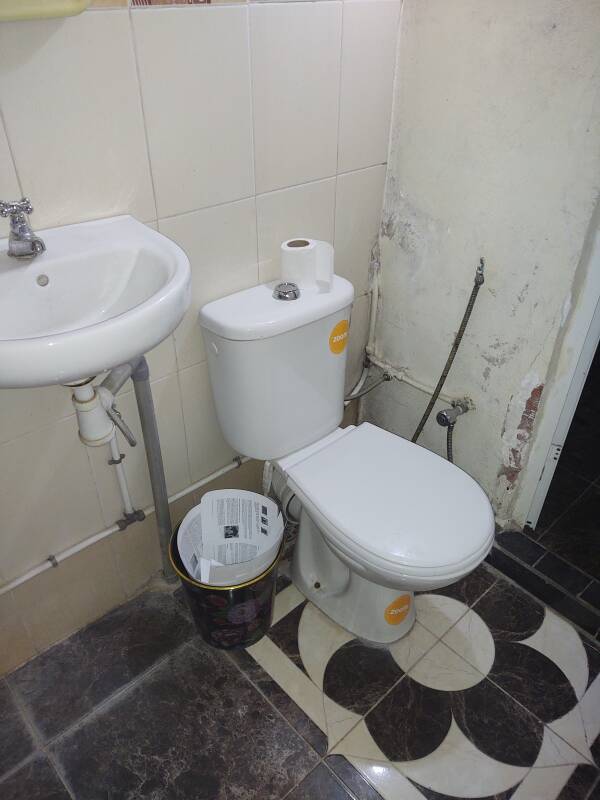
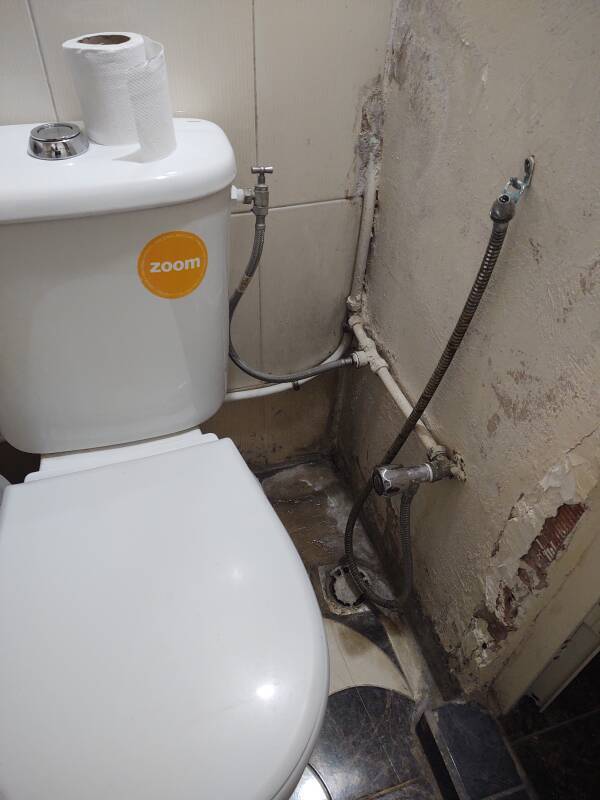
The water alternative is called a shattaf. This is the typical design, a thin rubber hose protected by a woven metal layer, with a simple conical nozzle at the end. This one has a small metal loop by which it hangs from a hook on the wall. Yes, the borders of the shattaf pictures are blue for a reason.
Notice the plumbing. The cold water lines comes down out of the wall and tees off to the toilet and the shattaf. It continues off to the left to reach the sink and the shower valves.
This is, as usual, a cold-water-only shattaf.
Breakfast was served on the rooftop, where they had a small zellij-tile-decorated fountain.
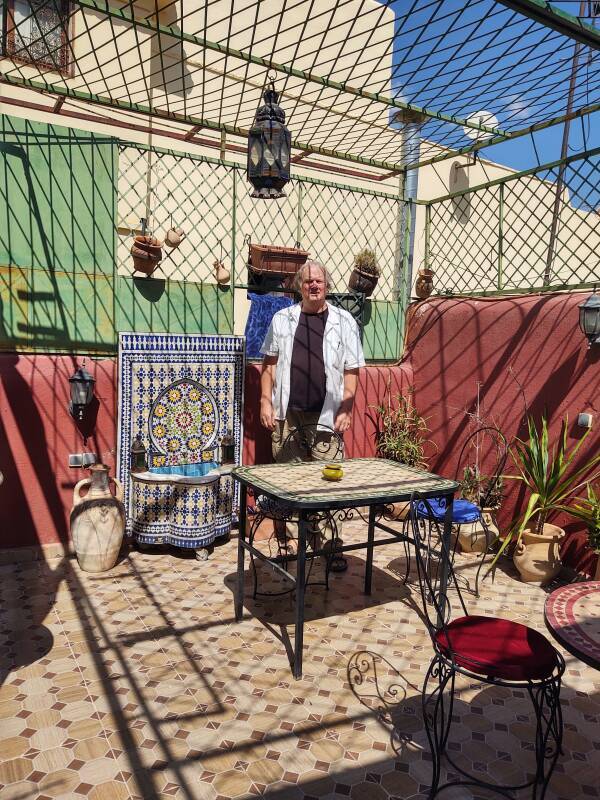
Fountains in the Medina
Tala'a Kebira runs from Bab Boujloud, an elaborate gateway through the inner medina wall, east to the large cluster of souqs near the Qarawiyyin Mosque, the main mosque of the city.
Along the way it's an open lane in places, running through buildings like a tunnel in other places.
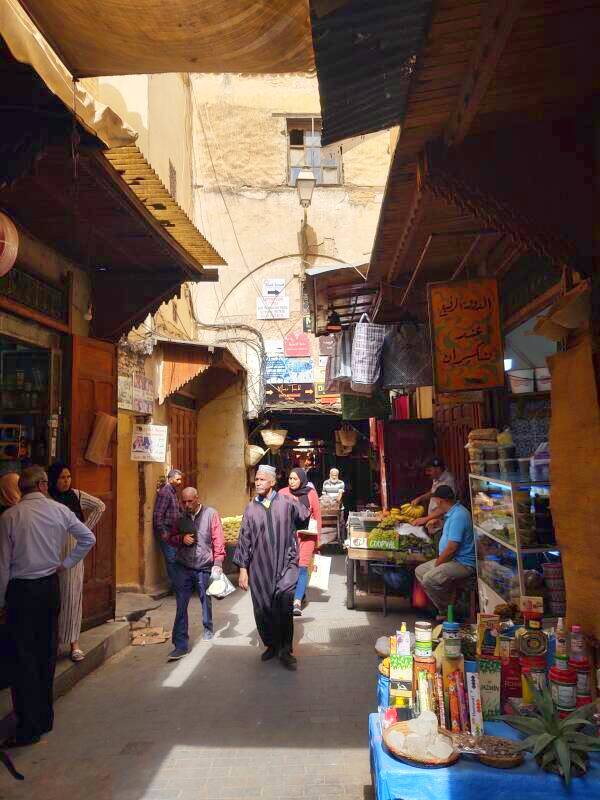
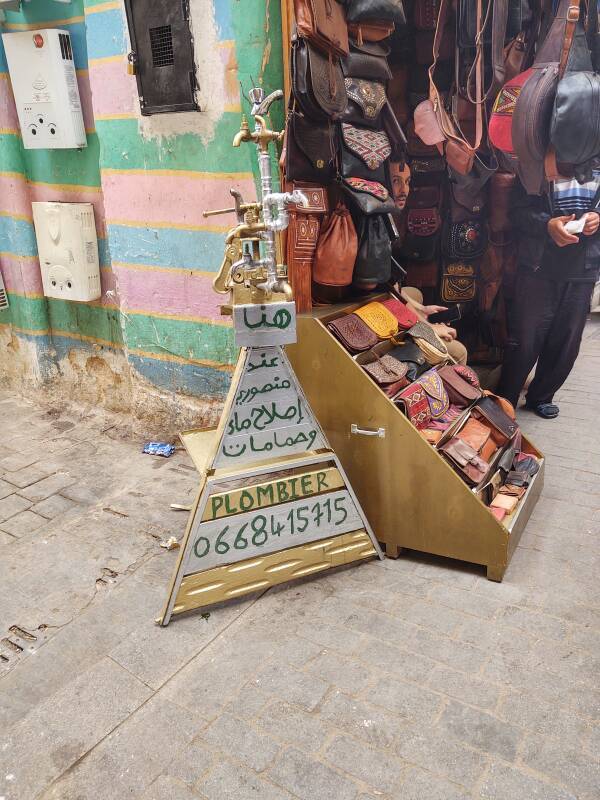
Tourists walk through here, of course. However, like the gravestone workshop, many of the shops will be of interest to local people only. For example, the plumber whose shop is back a derb off the main street, called out by a customized display.
You frequently pass decorated fountains.
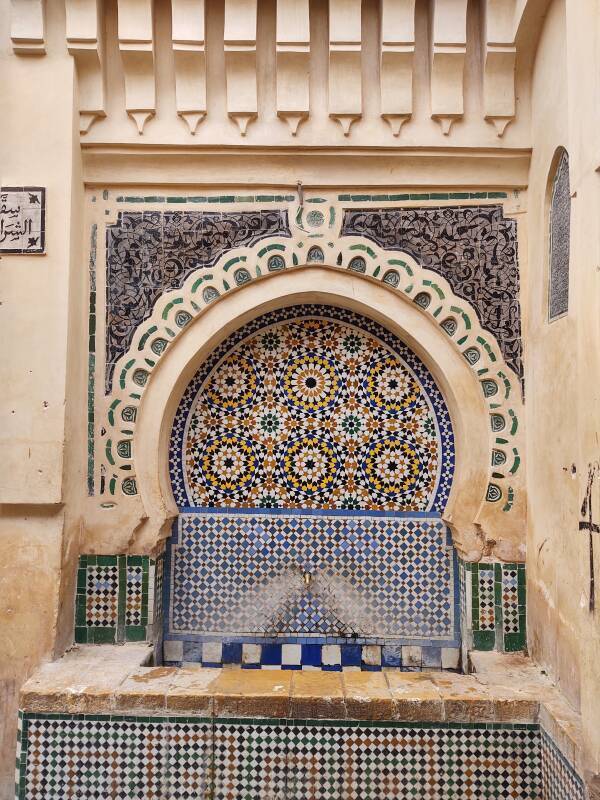
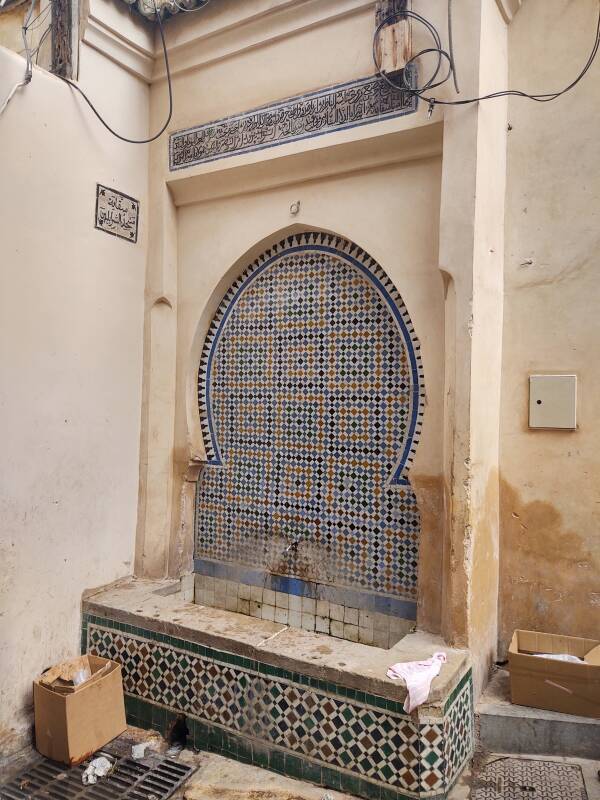
Sometimes the entry into the next neighborhood is a little more dramatic. This is the minaret of the Chrabliyine Mosque, named for the slipper souq that dominates the neighborhood's business.
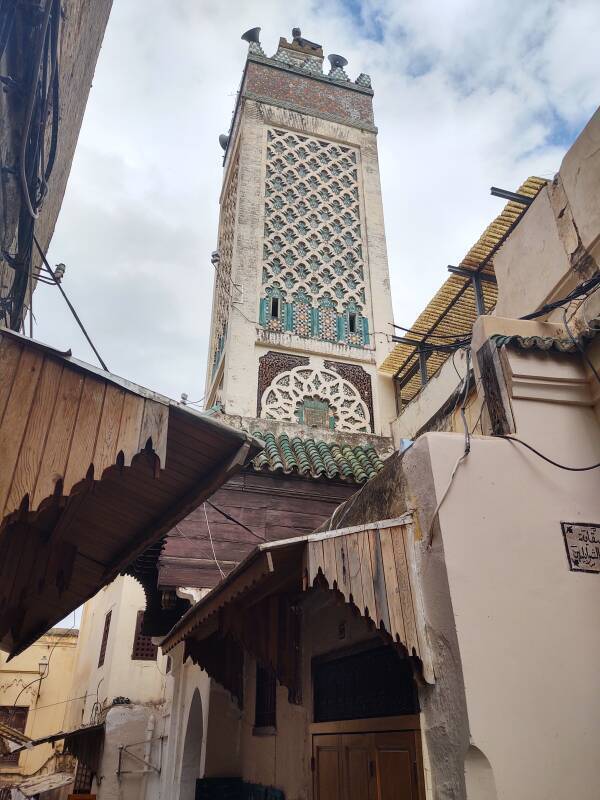
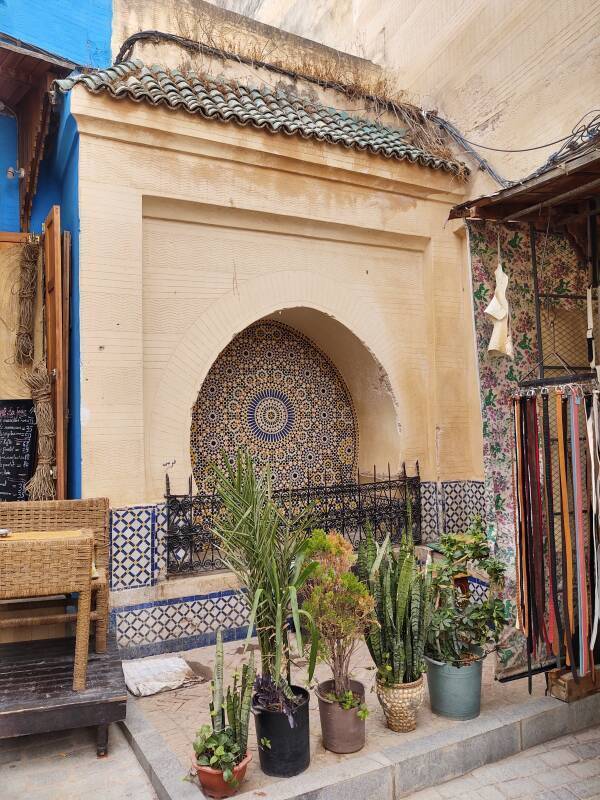
The above fountain is between a small café and a shop selling belts, purses, and other leather items.
Bou Inania Madrasa
The Bou Inania Madrasa is a spiritual and architectural high point of Fez. It was built in 1350–1355, commissioned by a sultan who wanted to boost his support among the religious elite and the common people. How better to do that than to appear as a protector of orthodox Islam?
Madrasas are religious schools. They also educated the scholars who operated the sultan's governmental bureaucracy.
Visiting theBou Inania Madrasa
You step through a carved wooden door from the busy Tala'a Kebira into the peaceful courtyard or sahn of the madrasa. The Bou Inania Madrasa is one of the few madrasas in Morocco to have a minaret and function as a congregational mosque.
A fountain and basin at the center of the courtyard allows for last-moment ablutions before entering the prayer hall, which extends across the far wall. Notice how you can sit on the outer edge of the channel around the fountain, remove your shoes and socks, and easily wash your feet. Small buckets make that even easier.
Teaching and study areas are in the galleries along either side, along with dormitory rooms for students. More dormitory rooms are on an upper floor along the three sides other than the prayer hall.
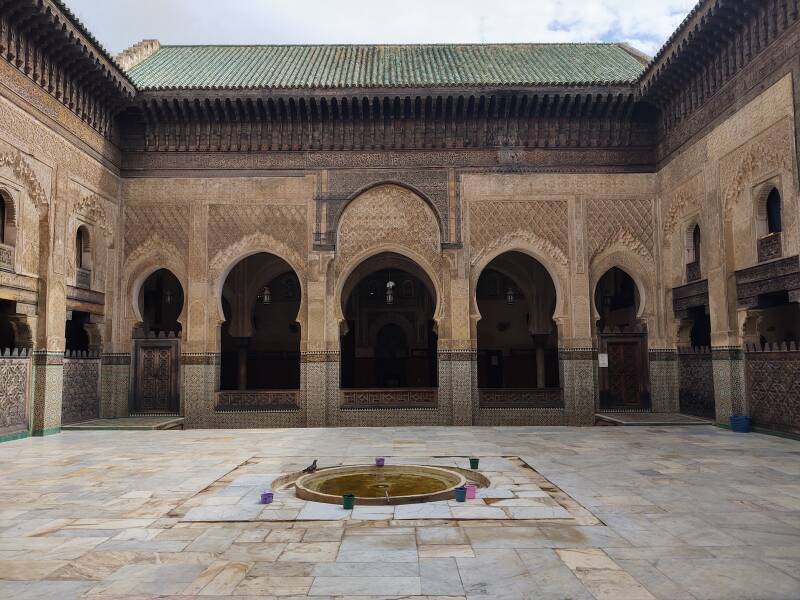
Water from a natural stream flowing through the neighborhood was diverted through this channel at the edge of the courtyard, along the front of the prayer hall. It's esthetically pleasing, it references the flowing streams and fountains of Paradise described in the Quran, and it provides even more last-moment ablution opportunities.
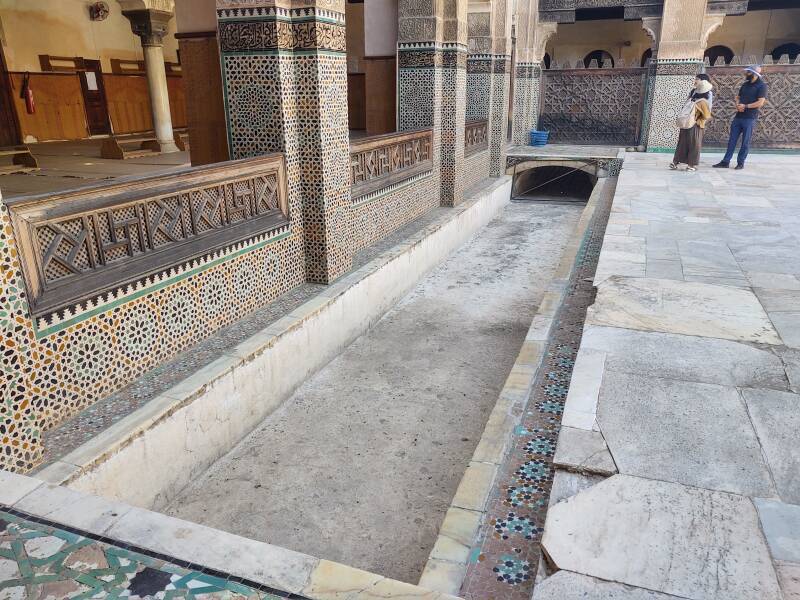
The mihrab is the horse-shoe-shaped niche in the front wall of the prayer hall. It indicates the qibla, the direction of prayer.
The qibla was always toward the south in the early centuries of Islam, based on a ḥādīth or tradition that Muhammad had said "Pray facing this way" while pointing south.
Islam spread all the way across northern Africa to Morocco, almost 5,000 kilometers west of Arabia. Then it occured to theologians that perhaps Muhammad had meant "toward Mecca" instead of "toward local south". But the gradual realignment of mosque design took centuries, and started after the mid-14-century construction of this one.
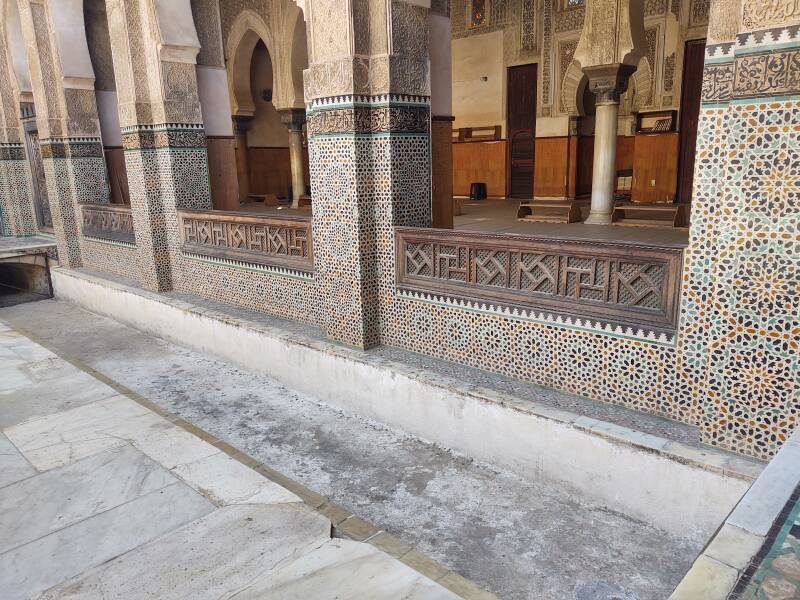
The Marinid dynasty sultan Faris ibn Ali Abu Inan al-Mutawakkil, generally referred to as Abu Inan, commissioned this madrasa's construction in 1350. The madrasa's name is based on the short form of his name.
Abu Inan had rebelled against his father and declared himself sultan in 1348. His father died in exile in the High Atlas mountains in 1351. Meanwhile, according to story of the madrasa's origin, Abu Inan felt guilty about violently overthrowing his father. He asked religious scholars to advise him on how to redeem himself and seek forgiveness from Allah.
The religious scholars advised the sultan to transform a set of public toilets and their cesspit into a facility for religious learning.
It was an enormously expensive project. One story describes how the construction supervisors nervously brought a detailed report on the cost to the sultan, who tore it up, threw it into the river, and declared "What is beautiful is not expensive, no matter how large the sum!"
Some theologians criticized the sultan because he had fallen in love and married one of his concubines. They suggested that her impure past made her unsuitable as the sultan's wife. He angrily responded with a reference to the newly built madrasa and its prayer hall, saying "Now you pray where you used to piss!" and so in his eyes she was similarly redeemed. Or so his reaction is described in English and French, I'm sure the original Arabic was similarly alliterative.
A variant of the origin story describes the site as a garbage dump and not toilets and a cesspit, but that gets in the way of that second part of the story.
The madrasa was completed in 1355. On 10 January 1358, the sultan Abu Inan was strangled by his own vizier. The dynasty was declining. All the following Marinid sultans were puppets controlled by their viziers. It's good to be the sultan, right up to the point when your vizier starts having ideas.
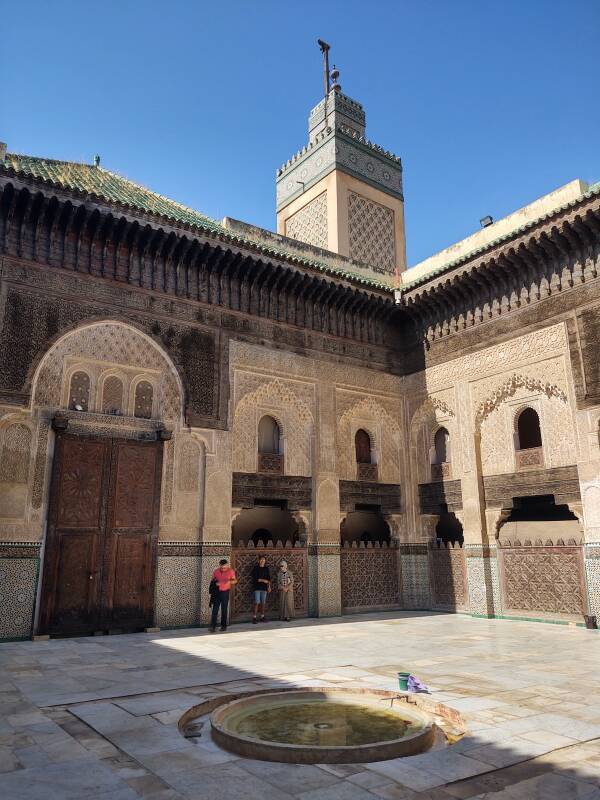
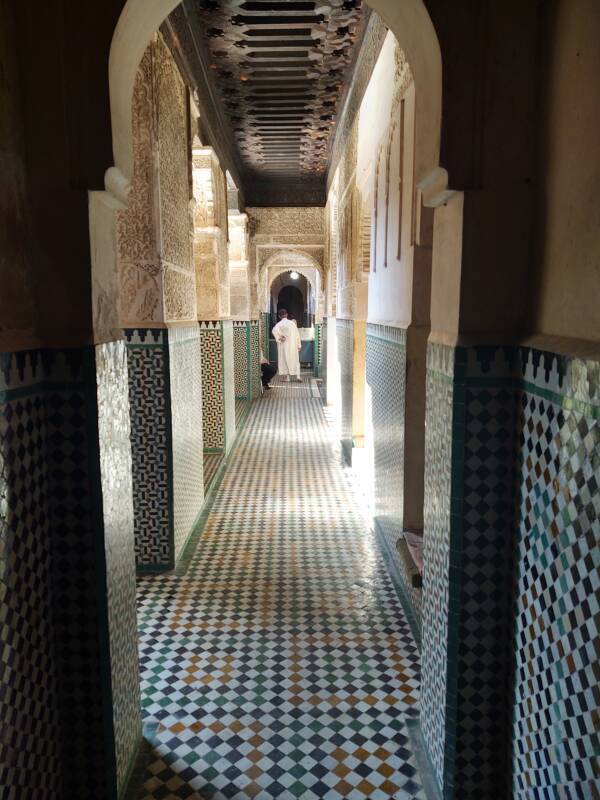
Ask to use the toilet while you're visiting the madrasa. You'll be sent down a hall, seen above. The men's toilet is dominated by a rectangular ablutions tank. Again, you sit on the edge of the floor around it with your feet in the channel. Remove your shoes and socks and wash your hands, feet, and face.
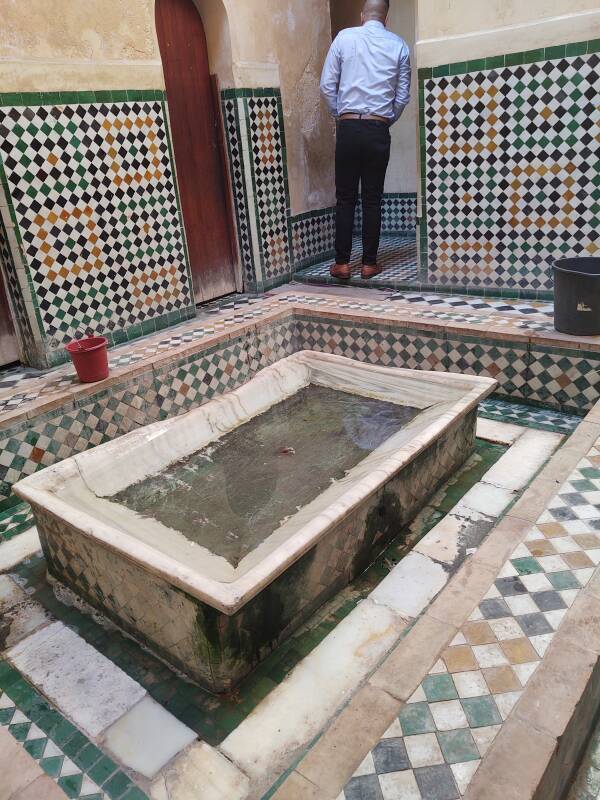
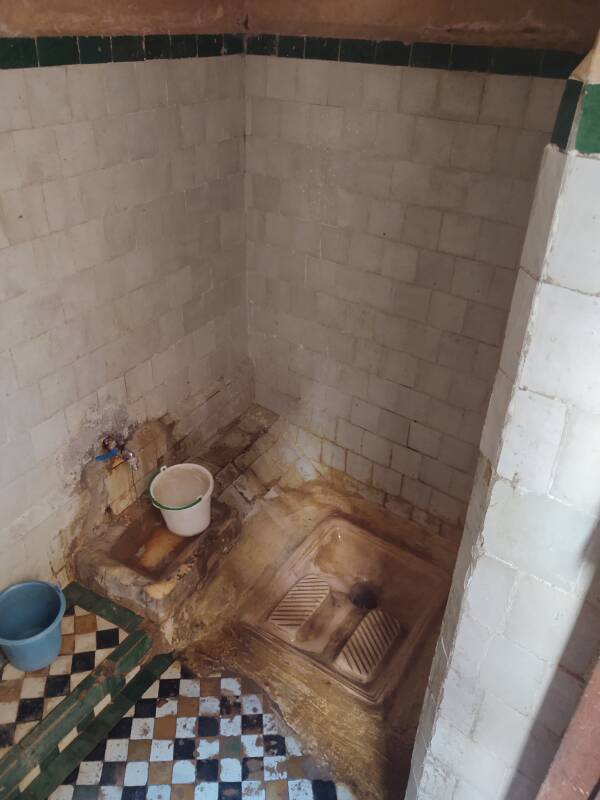
As for the toilets, both traditional and European style are available.
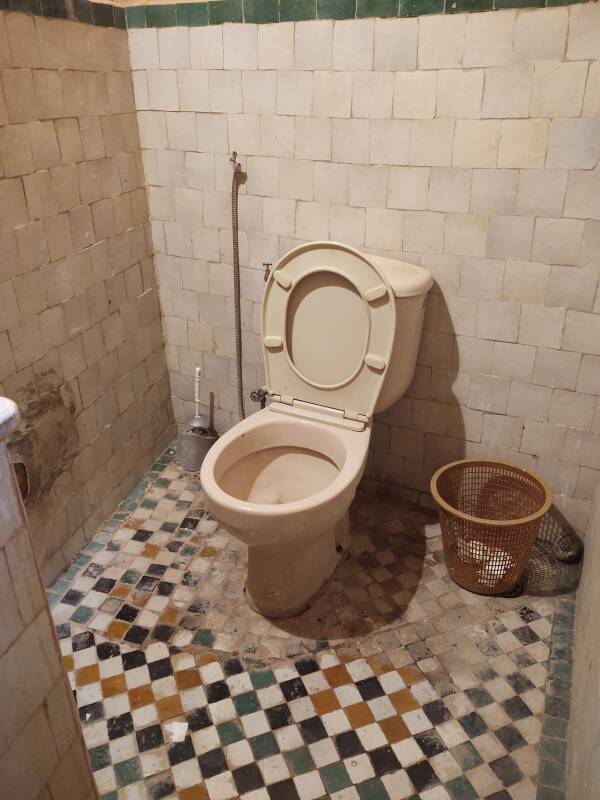
Dar al-Wuḍū or the House of Ablutions is just outside, across Tala'a Kebira. It's part of the same complex, joined by an arch over the street. It contains latrines and larger washing facilities. Here we see a man in the archway, next to the closed door to the House of Ablutions. He's selling spearmint for the Moroccan national drink — hot, sweet, mint tea.
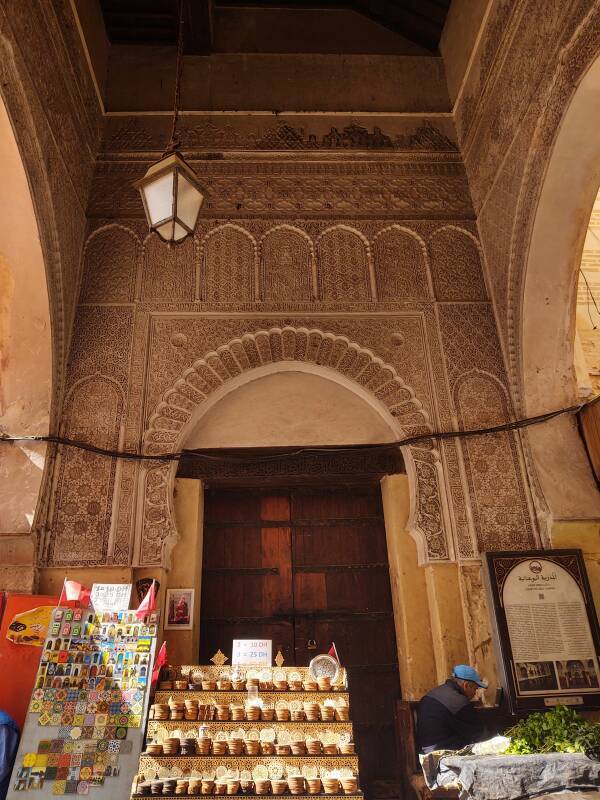
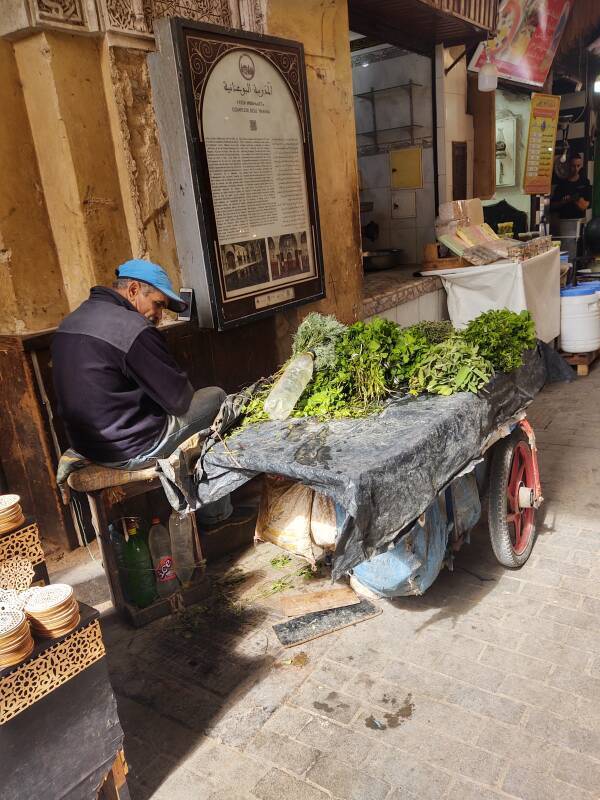
Adjacent to Dar al-Wuḍū is Dar al-Magana or the House of the Clock, home to a famous water-powered clock which no longer functions. The building is sometimes called the "House of Maimonides" because of a popular legend that the famous Jewish philosopher once lived here while studying or teaching at the madrasa.
A mosque needs a way to determine the correct times of prayer. The job is carried out by the muwaqqit or timekeeper, who needs some clock mechanism. Abu Inan also had this structure built before his vizier strangled him.
Above the busy street it has twelve windows above brackets which once supported a series of twelve bronze bowls. Every hour the shutters of a window opened and a lead ball fell into the bowl below, making a ringing sound. Closer spaced longer brackets above the windows supported an awning. The archway joining the House of Ablutions to the madrasa is at right.
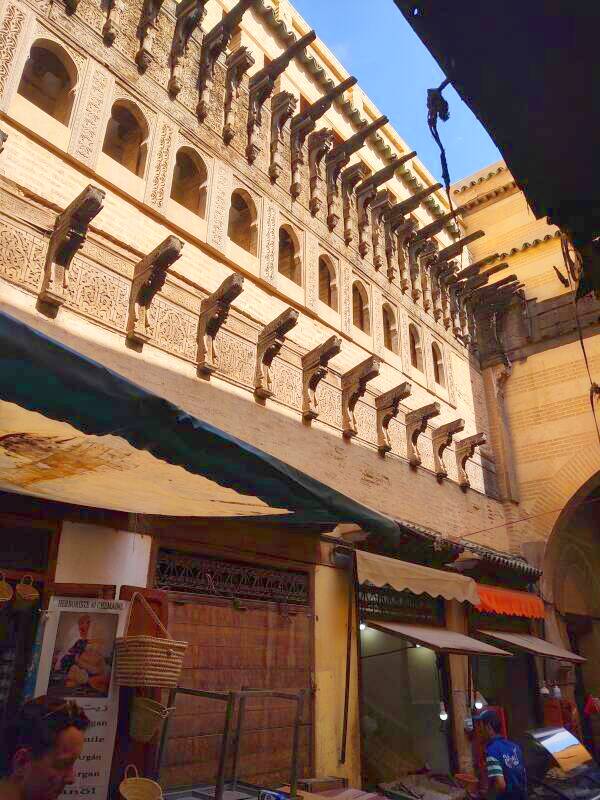
Descriptions of the clock from an era in which it still worked say that it was powered by running water. The remaining bronze bowls were removed for study in the late 20th century, and haven't been replaced despite a restoration of the structure in the early 2000s.
The clock mechanism remains a mystery. One theory is that a small cart moved from left to right behind the windows, slowly pulled by a rope attached to a float in a slowly draining tank. When the cart reached a window, it somehow opened the shutter and released one ball. It's all vague, the details have been lost.
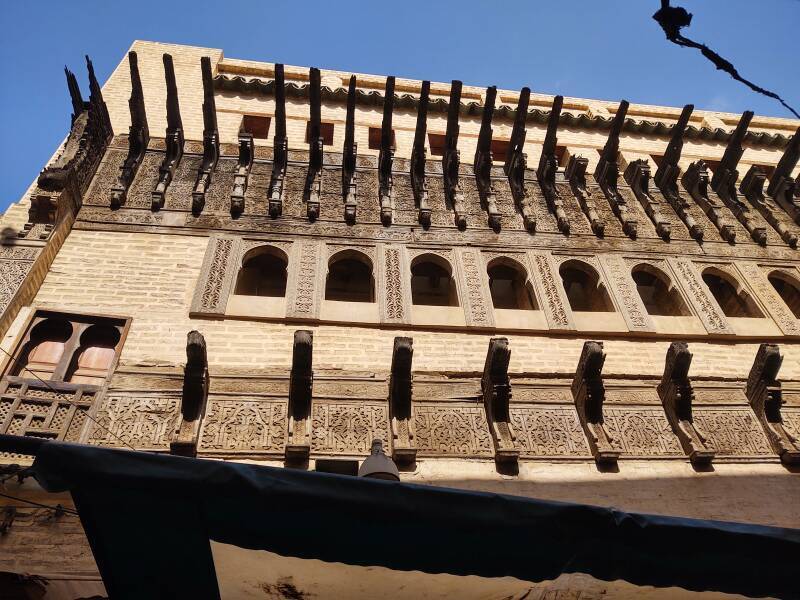
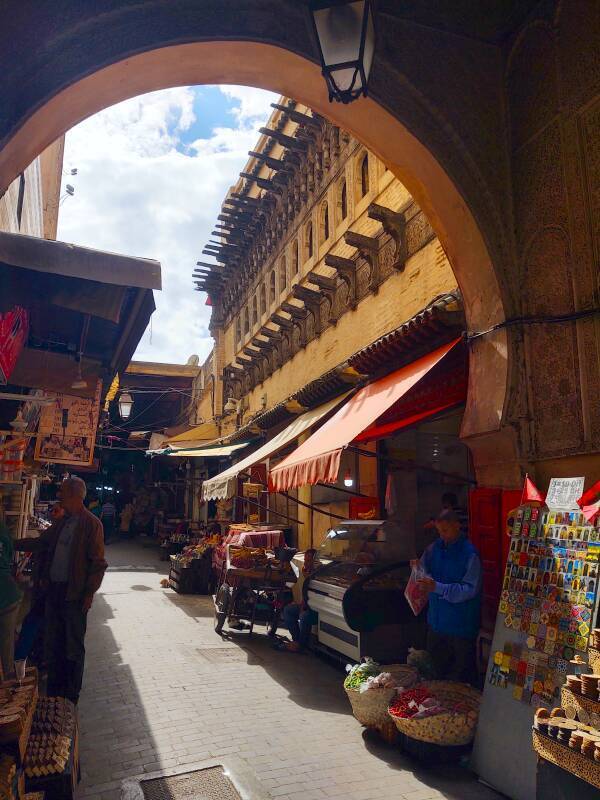
Hammam Fountain and Toilet
A half-day tour of the medina organized by my guesthouse took me, as expected, to several shops where the guide hoped I would make many purchases and bring him commissions in addition to his fee. He had only very limited luck on that front.
We went to several places that weren't shops, however, including a hammam which, of course, focuses on water and plumbing features.
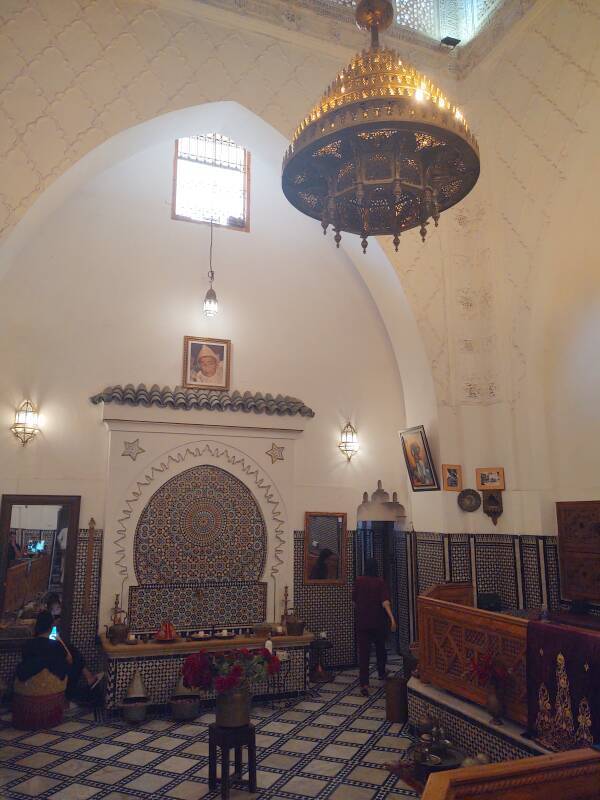
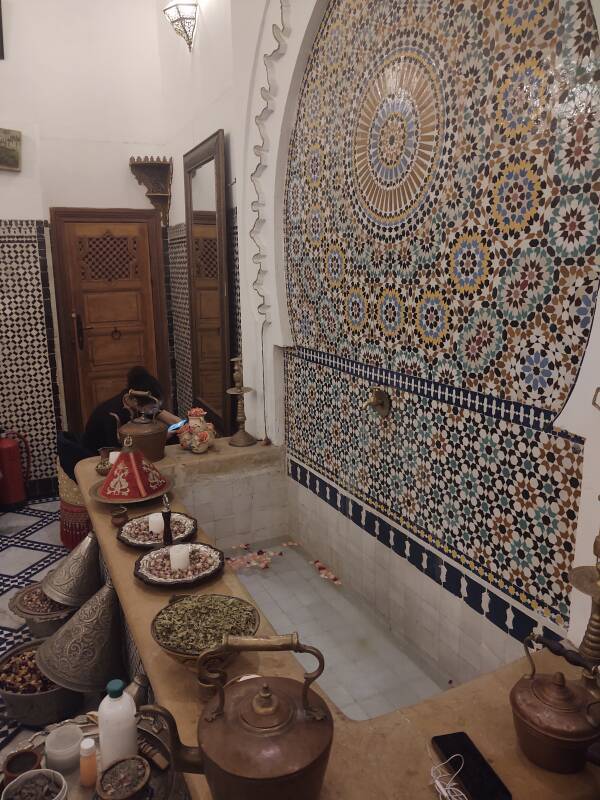
That included a toilet within the warm, foggy, soap-scented back hallways.
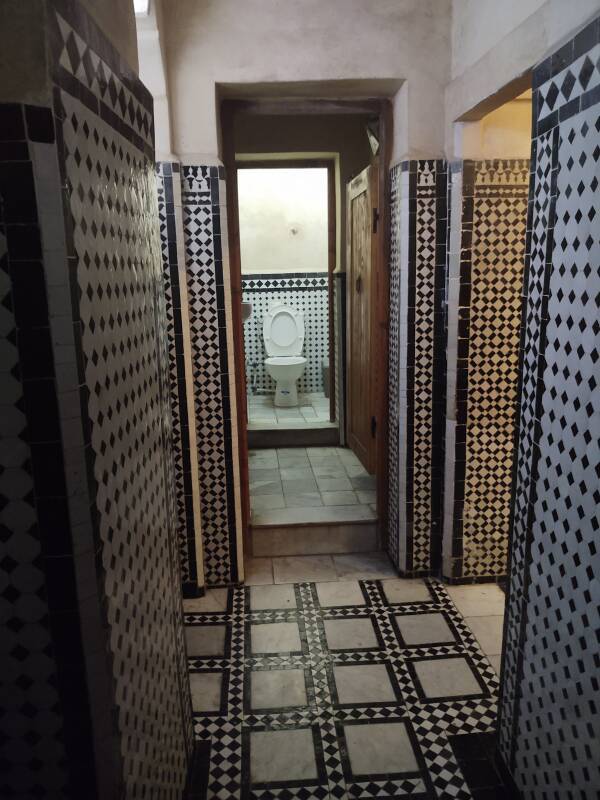
There's much more to see at Fez, see my general travel page.
If you're following the pages in the order I visited places during my trip, the next stop is the city of Marrakech. Or, feel free to jump around:
